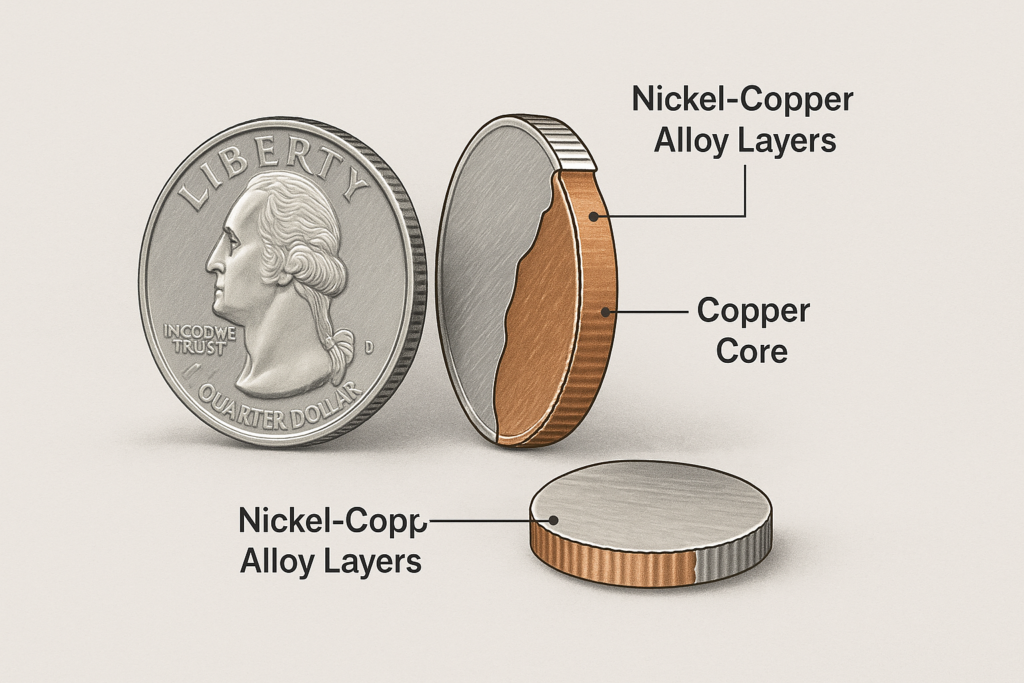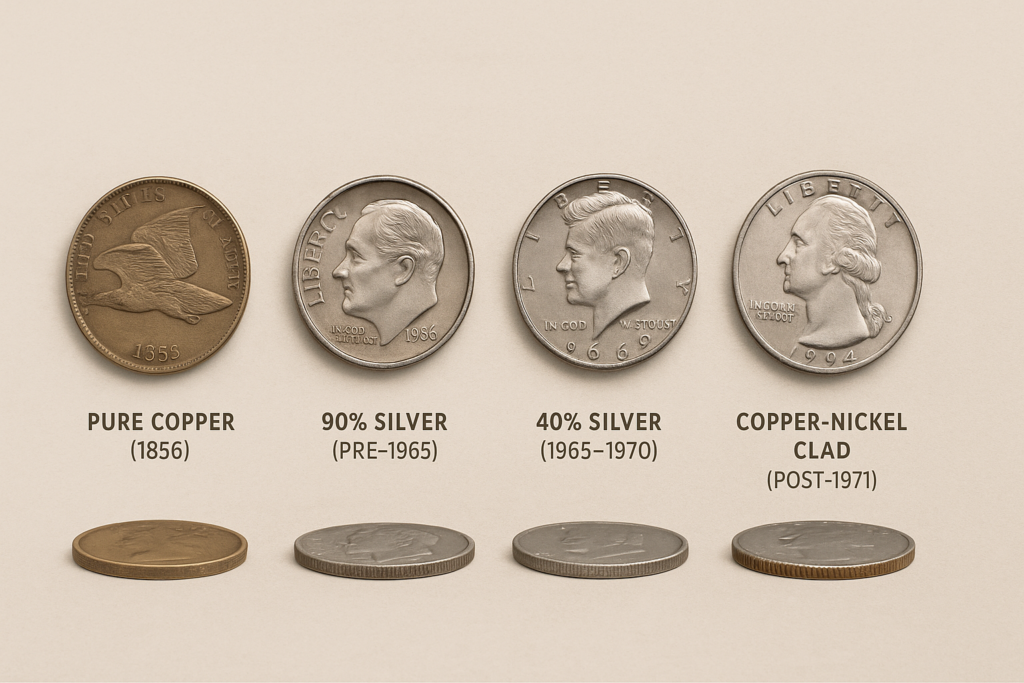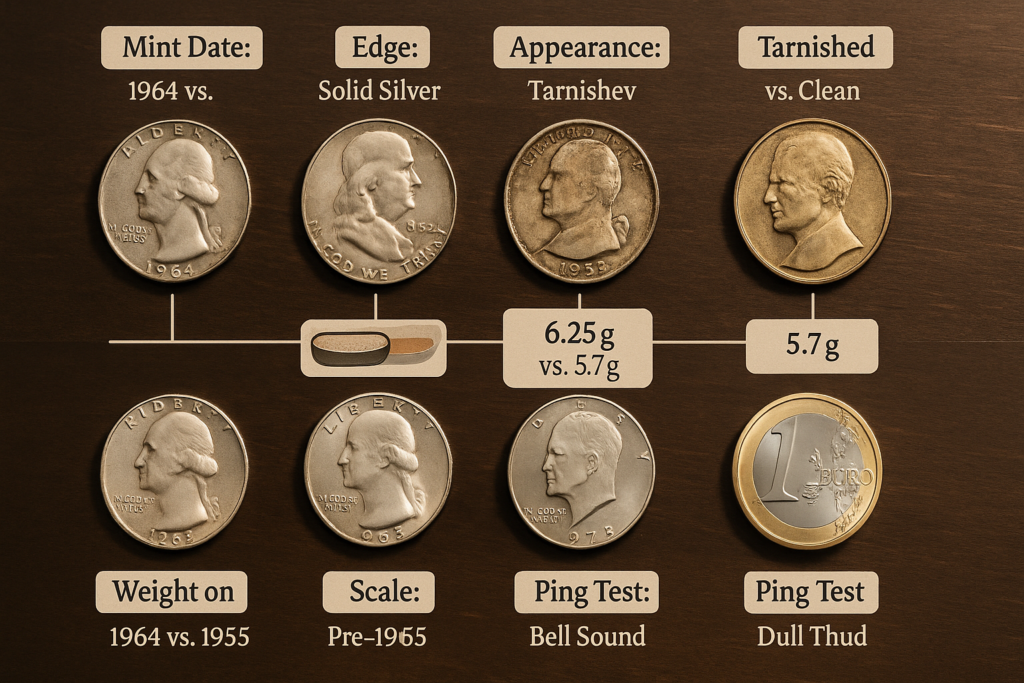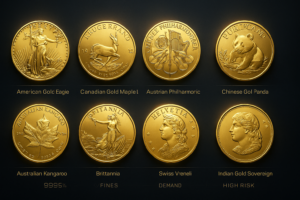You may have heard the term ‘clad coins’ and the hype related to it in the coin-collecting arena. But do you know what it actually is?
Even a lot of long-time collectors tend to confuse clad with bimetallic coins. They are not to be blamed though, since these technical numismatic terms can often get very confusing.
So, it’s always a good idea to learn something new and enrich yourself with subtle yet powerful intricate information and knowledge of various recurring terminologies as much as possible. This is what this article is going to do for you.
Keep on reading to know what clad coins are, their mintage, the difference between them and bimetallic coins, and more.
Defining ‘Clad Coins’

A clad coin is one that contains several layers of metal.
By definition, “clad” refers to the link between multiple outer layers of a metal and the interior of another metal.
Technically, several items such as frying pans, cooking pots, and other kitchenware—can be clad.
Clad coinage often gets a bad reputation. People categorize it as a counterfeit, scam, rip-off, etc, very quickly. But the truth is, clad offers numerous benefits – it’s thick and resists wear and corrosion. It’s sturdy and has good looks.
The majority of modern clad coins have an inner core made of pure copper and outer layers made of an alloy of nickel and copper that resembles silver. The United States Half Dollar and Quarter are examples of clad coins.
Three layers of metal are used to clad the dime, quarter, and half-dollar coins. The two identical outer layers comprise an alloy containing 25% nickel and 75% copper. Copper makes up the inner layer. A minimum of 30% of the coin’s weight is composed of the outer layers, which are metallurgically joined to the inner layer.
The “golden dollar” coinage, such as the Presidential Dollars and the Sacagawea Dollar, are also clad. They are constructed of an alloy of copper, nickel, zinc, and manganese, with a core that is entirely made of copper.
The Mintage Specifications Of Clad Coins
The process of bonding together thin, light layers of metal in various alloys to create a sandwich structure is known as cladding or cladding. The innermost layer of a clad coin is referred to as the core, and the outer, or exposed, layers are known as the lamina or clad layer.
The physical features of the outer/ clad composition, such as the color, appearance, hardness, and electrical sensitivity of such surfaces, are considered in every case. The usage of the core typically involves less cost than the use of clad metal.
On the edge of U.S. coins produced after 1965, you can see the boundary, or line dividing the core from the clad metal. However, other European coins, like those from Sweden, are different because they have an edge that is upset to cover the core.
Let’s take a look at the mintage specifications of some of the most commonly known US. clad coins –
$1 Dollar Clad Coinage
The dollar coin would be a golden color, feature a distinct edge, and have tactile and optical characteristics that make it easy to recognize the coin’s denomination.
They are minted in the US. and have the same metallic, anti-counterfeiting qualities as US. coins that were in circulation on the day the US $1 Coin Act of 1997 took effect.
Other US. Clad Coins
- Alloy specifications are weight-based.
- The 5-cent coinage is composed of 75% copper and 25% nickel. When minting these 5-cent coins, the Secretary must use bars that differ by no more than 2.5 % from the required nickel percentage.
- The one-cent coin consists of 95% copper and 5% zinc.
- When minting clad coins of gold, the Secretary shall utilize alloys that differ by not more than 0.1 % from the required percentage of gold.
The Making Of Clad Strips For Coins
Ingots of the proper composition are repeatedly rolled to a thickness multiple times that of the target coin. They are pickled-cleaned metal. The layers are then arranged properly in a rolling mill, with the core sandwiched between the two outer layers.
The 2 types of bonding mechanisms are –
1. Roll Bonding:
Roll Bonding is possible if the metallic strips are pre-heated and ready to go for rolling under pressure and heat.
2. Explosion Bonding:
They could be bonded using explosion bonding if they have been cold-rolled. The strips are thereafter rolled successively until the desired thickness is achieved.
Clad Strips In The US. Mints
The US. Philadelphia and Denver Mints have been receiving clad strips of the copper-nickel lamina (clad layer) on copper core since January 1994 from PMX Industries located in Cedar Rapids, Iowa, which employ the roll bonded process. Each strip is around 1,000 feet long and weighs from 3,000 to 7,000 pounds.
These are the dimensions of the strips –
| Coin Denomination | Thickness | Width |
| 10 Cent | .041 inch (1.041 mm) | 12 11/16 inch (322.26 mm) |
| 25 Cent | .0545 inch (1.384 mm) | 12 13/16 inch (325.43 mm) |
| 50 Cent | .0685 inch (1.740 mm) | 12 9/16 inch (319.08 mm) |
For any denomination of clad strip, the thickness must be produced within a tolerance of .0015 inch (.038mm). The mints blank these strips and then return the skeleton scrap of the strips to the supplier. By adding new nickel to the right formula (25% nickel, 75% copper) for new copper-nickel clad layers, the supplier retrieves the scrap.
75% of the strip is blanked by the mints (73% at the Philadelphia Mint), and the remaining portion is returned. By upsetting machinery, the blanks are then struck in the coining presses inside the mint.
The US. Mint has lately outsourced the blanking, along with the formulation and rolling, to private companies. Therefore, saving on shipping the skeleton junk for reprocessing results in cost savings. Blanks are delivered to the mint for the required upsetting and striking by the mint’s workers.
The Properties Of Clad Coinage
Only the outer layer/ lamina on either side contributes to surface displacement when the clad blanks are struck, especially during coining. It has no impact on the inner core. Metal is drawn into the die cavities from deep within solid blanks along with surface movement.
The limit on these blanks literally serves as an edge over which no core metal flow takes place. When the lamina separates from the core, this becomes quite clear. Clad compositions successfully reduce ghosting or suction in striking pieces to some extent.
Minting Anomalies/ Errors In Clad Coins
After a clad composition is selected for use in the national history of coinage, there is a chance for a new set of errors. Creating a new category of lamination errors includes the debonding of the lamina layer.
Before the coin striking takes place, one anomaly can be something resulting in a light blank with poor detail. Or another anomaly after striking the coin, with clad metal occasionally still in place but more frequently split. The separation of the clad layer is referred to as ‘peeling’.
A dropped letter occurs when a letter from the high-stress section of the legend is impressed into another coinage if the separated lamina flakes off and falls onto another blank while still in the coining press.
Collectors refer to a coin as a ‘clamshell’ if the metal flake is still adhering to it, and the spot where it’s still attached is referred to as the ‘hinge’.
The Difference Between Clad And Bimetallic Coins
Clad coins differ from bimetallic coins, and they are not the same thing. The most important factors are the metallic composition of these coins and the way the metals are bonded together.
A bimetallic coin is a coin made of two different types of metal, while a clad coin is a coin that is made of two layers of metal. Bimetallic coins often have a core of one metal, such as copper, and an outer layer of another metal, such as nickel or silver. This gives the coin a unique appearance and added durability.
Clad coins, on the other hand, have two layers of metal that have been bonded together. The inner layer is usually made of copper, while the outer layer is made of a different metal, such as nickel or silver. This can make the coin more durable and resistant to wear and tear.
A Brief History Of U.S. Clad Coinage
There have been instances throughout coinage history where the intrinsic value, meaning the actual worth, of the metal started to surpass the face value/ denomination of the coin. One of the most notable examples is the launch of the U.S small cent back in 1856.

The United States Mint was compelled to change the weight of copper pennies. Those coins, which were previously 10.886 grams of pure copper, started to contain 4.670 grams of the copper alloy due to the growing price of copper.
Or else, people would’ve taken the large cents out of circulation and retrieved the copper value from them by melting them. This would have resulted in a small-change coin shortage in the U.S.
External market forces exerted pressure on more than just copper coins. To discourage individuals from melting silver coins for their metal content, the weight of silver coins was reduced in the mid-1800s. Midway through the 1960s, the United States underwent a thorough modernization of its silver coinage due to the same market dynamics.
The United States suffered from a serious coin shortage from 1963 to 1965. Silver bullion prices were rising and supplies were declining at the same time. The US Treasury Department linked the coin shortage to coin collectors.
In reality, it was normal for everyday people to realize that the silver content’s intrinsic value outweighed the coin’s face value. Because of this, some people decided to remove the silver coins from circulation to melt them for their precious metals’ bullion value.
The one who removed the coins from circulation would then make a sizable profit as a result. The same can be said about the penny and nickel today. Before 1980, pennies contained copper worth more than one cent. However, melting value pennies and nickels is illegal in the United States.
Modern coins have to get past counterfeit rejection systems in vending machines, unlike the ones from the middle of the 1800s. The U. S. Mint was required to create a different metal alloy that contained the same characteristics as a 90% silver coinage while being significantly cheaper to produce.
The vending machine manufacturers predicted that it would take a minimum of 5 years to convert several million vending machines to recognize a new coin makeup if this crucial step wasn’t taken.
The Treasury Department spoke with the Battelle Institute, which advised using a clad metal composition, also known as sandwich metal, made up of a light copper-nickel alloy-based outer layer connected to a pure copper core. This shift in the metallic composition of dimes, quarters, and finally half dollars became a reality thanks to the Coinage Act on July 23, 1965.
The content of silver was decreased when the half dollar’s design was altered to honor John F. Kennedy by employing clad outer layers containing 80% silver joined to an inner layer of 79% copper and 21% silver. This resulted in the silver half dollars from 1965 to 1970 having an overall content of 40% pure silver.
Half-dollar coins have a similar clad composition as dimes, quarters, and dollars as of 1971.
Clad Coins Of Gold And Silver As Collectibles
Clad isn’t pure gold or silver and it is inexpensive to purchase. The purpose of collecting some is precisely to do that. You can have the same fantastic look without spending a fortune. A clad coin with gold or silver content is thus a popular collector’s item.
You may need something that works well and is appealing. Gold or silver-clad coins are a great choice only if you know and understand what you are buying.
Think of cladding as eating utensils that are silver- or gold-plated or as replica pirate coins. Because they are as close to the real thing as you can get without spending lots of money, replica pirate coins are what you buy. The eating utensils follow the same principle.
Cautionary Info
The United States Mint does not make or sell gold/silver-clad coins. Any product that is advertised in this manner requires proper study regarding what it actually contains.
Always use caution when buying pure solid gold coins, and be sure they are issued by a reputed and authentic mint. If not, you might end up purchasing something that isn’t worth what you paid for it.
5 Hacks To Differentiate Between A Silver And A Clad Coin

Every potential coin dealer and collector should know how to evaluate a coin and precisely determine its composition. The ability to do so will help you save money and prevent scams. Understanding if a coinage is pure silver or clad is one such crucial skill.
It is usually simple to tell whether a coinage is silver or clad. However, in some instances, it is necessary to go through the testing and research processes to confirm the accuracy of an identification.
Here are 5 effective hacks –
1. Checking Mint Date
You can check the coin’s mint date. With a few notable exceptions, the majority of coins produced after 1964 are clad.
Notable Exceptions
- The Bicentennial Quarters:
The US Mint’s special edition sets of bicentennial quarters with two dates were the exception to this rule. 40% of the silver in the bicentennial quarters was silver. There is an ‘S’ mark on the quarters that contain this mixture.
These silver Bicentennial quarter coins were not distributed to the general public for use as regular coinage. Each was provided to collectors and dealers by the US. Mint at a premium price.
- 1965-1970 Half Dollars:
The half dollars issued from 1965 to 1970 were 40% silver. The copper-nickel composition of silver half-dollars began to be used after 1970. In 1976, the US Bicentennial year, a special exception was established, similar to how it was with quarters.
Uncirculated mint sets of the half-dollar coins from that year had the ‘S’ imprint and were made of 40% silver. They were also offered at a discounted price to collectors and dealers.
- 1971–1974 Eisenhower Dollars:
A 40% silver content was used in the 1971–1974 silver Eisenhower dollars. The ‘S’ imprint on the coin’s face served as a reminder of this. The ‘S’ stamp and 40% silver were also features of the 1976 edition. Copper-nickel-clad coins are the only other Eisenhower silver dollar coins available.
Considering the aforementioned exceptions, any coin from 1965 and afterward that is a US coinage is clad. The coin’s asking price ought to reflect this.
2. Checking The Edges
Additionally, clad coins may feature a copper outer ring around the edge, whereas silver coins do not. The copper outer ring is a sure thing, barring the mint date, which is usually a dead giveaway.
The presence of a copper ring indicates that the coin is clad, until or unless you are dealing with a counterfeit.
3. Checking The Condition/ Appearance
Check the coin’s general appearance/condition if you are still unsure whether it’s silver or clad. With time, silver coins tarnish.
Silver develops a tarnish tint when it is exposed to air. A tarnished coin would exhibit the most coloring around any imprinted designs, between the side ridges, and along the edges per each flat surface. The tarnish will appear virtually black in those cases.
The tarnish on the coin will appear greyish where it is exposed. Instead of tarnishing with time, clad coins take on a faintly coppery hue.
Note:
Make sure you are not merely examining a dirty coin when analyzing the amount of tarnish on the coin. A clad coin may have tarnish-like dirt on it in some situations.
4. Weighing The Coin
If you pay attention to the coin’s weight, you can tell if it is silver or clad.
A silver Washington quarter, for instance, weighs 6.25 grams. Washington clad quarters have a 5.7-gram weight. The weight disparity between the half-dollar and dollar coins is considerably more obvious.
The only exception is dimes, which can be challenging to differentiate. When dealing with dimes, it is preferable to digitally weigh every coin as opposed to one that you are sure is clad (any US. coin from 1965 to the present day).
You can tell a dime is not a 90% silver coin if it isn’t heavier than the coin that has been identified as clad.
5. Performing The Ping Test
You can also perform a ping test. When dropped, silver coins make a different sound than clad ones. Coins made of silver typically exhibit a higher pitch as well as a distinct ring.
Clad coins fall more heavily and make a lower-pitched sound. Additionally, clad coins won’t have much, if any, ring at all.
If at all possible, avoid dropping the coin unless there are still unanswered questions following the previous tests. Dropping a coin for grading has the potential to harm it. This is the last resort.
The main distinction between coins that are mostly made of silver and ones that are clad is in their respective metal compositions. Technically, a coin is considered to be silver if it contains silver. The amount of silver in the coin’s total composition serves as the line of distinction.
How this works is well demonstrated by the function of silver in coinage in terms of the US. monetary policy, including both coins that were primarily made of silver and coins with silver cladding.
Conclusion
Hopefully, this article has addressed most of the things you needed to know about clad coins. You can now tell the key differences, the specifications, and the overall ins and outs of clad coin mintage without an iota of confusion.
FAQs Related To Clad Coins
What Years Are Clad Coins?
Nov. 1, 1965, saw the arrival of the first clad coins, while the Mint continued to make silver coins with 1964 dates until April 1966.
Denver, Philadelphia, and San Francisco – these three mints would keep producing 1965-dated coins up to August 1, 1966, when production switched to 1966-dated coins.
The desired result of the actions taken to improve coinage production was the elimination of the coin deficit. Silver coins vanished from circulation over the following years, owing to Gresham’s Law, which states that bad money forces out good.
By 1970, silver coins had almost entirely disappeared from regular circulation.
How Do You Tell If A Coin Is Clad?
Here are some ways to tell that a coin is clad –
- You can find out when the coin was struck. All coins made after 1964, with a few significant exceptions, are clad.
- Clad coins commonly feature an outer ring around the edge.
- With time, clad coins take on a faintly coppery hue.
- Another option is to run a ping test. Coins that are clad make a lower-pitched sound. Furthermore, clad coins will have little to ring at all.
Are Clad Coins Worth Anything?
The majority of copper-nickel clad quarters in circulation are just worth their face value. However, if you know what to hunt, you might find some remarkably excellent coins that are worth significantly more than just 25 cents.
Here are some statehood quarters and Washington quarter clad coins that worth much more than their face value –
- 1983-P Washington quarter
- 2005-P Minnesota doubled die quarter
- 2005-P Kansas ‘IN GOD WE RUST’ quarter
Other coinages from the modern era of clad (1965-present), including errors, variations, and regular-issue coins, can be spotted in circulation and are worth far beyond their face values. Roll searching and bag scanning are two of the most effective methods for locating such coins.
Keep a lookout, and you might come across some lucky finds.
Do Clad Coins Tarnish?
Clad coins don’t tarnish the typical way silver coins do. Instead, clad coins will age with a coppery hue.
Copper-nickel coins have a circulation life of at least 30 years. This is one of the reasons copper-nickel was selected for circulation in many countries.
Coins with copper and nickel content are far more sanitary than those without these metals. The reason behind this is that copper surfaces effectively and swiftly eliminate harmful germs, viruses, and fungi.
Coins made of copper-nickel alloy are thus corrosion-resistant Therefore, they do not tarnish.
How Do You Tell If A Coin Is Missing Clad?
A reddish-brown ring can be observed around a clad coin’s edge if you look closely. This is the copper core. The error happens when one of the outer layers of clad nickel separates and dislodges from the planchet, revealing the copper inside either before or following striking.
There are different levels of nickel clad-layer missing in missing clad-layer coins. If any nickel-clad layer is still present on the coin, the amount of exposed copper is used to define the missing clad layer.
For instance, the obverse clad coating on the 1997-P 25 cents would be classified as “80% missing.” This is due to the nickel layer’s 80% loss. A coin would be referred to as having “100% missing reverse clad-layer,” or just “missing reverse clad-layer,” if the nickel cladding were entirely absent.
Even if partial-missing clad layers are rarer than fully-missing clad layers, they are always worth considerably less than completely missing clad layers coins.

![You are currently viewing What Is A Clad Coin? [Everything You Need To Know]](https://coincollectorium.com/wp-content/uploads/2025/06/ChatGPT-Image-Jun-20-2025-12_04_33-AM.png)


![Read more about the article What Is A Commemorative Coin? [A Comprehensive Analysis]](https://coincollectorium.com/wp-content/uploads/2023/10/What-Is-A-Commemorative-Coin-300x158.webp)